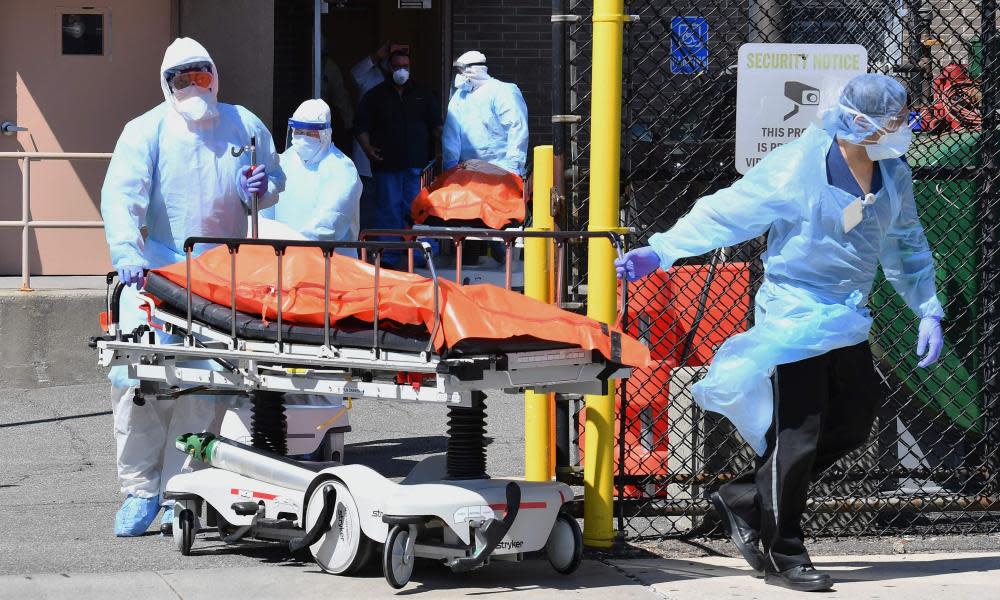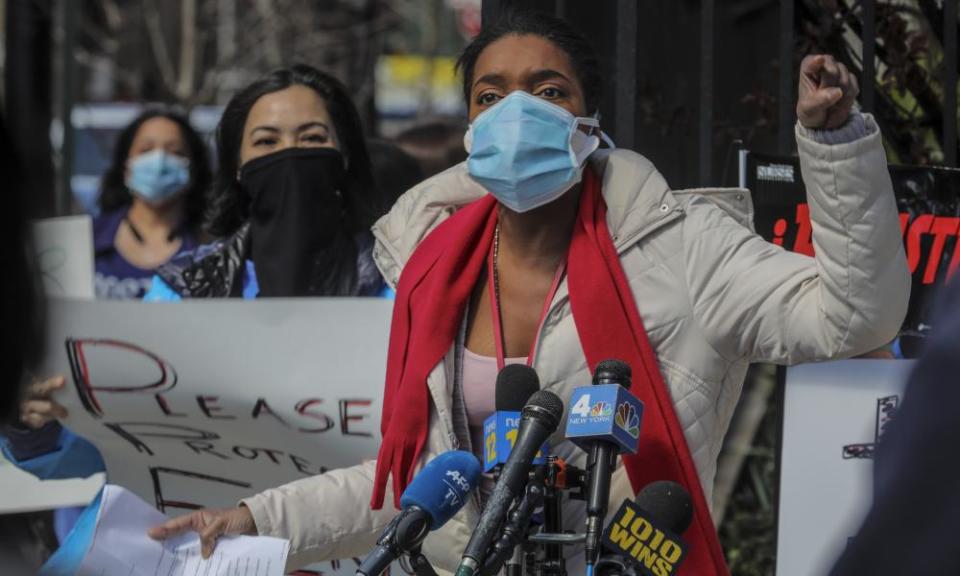New York only has enough ventilators for six more days, says Governor Cuomo

New York has confirmed 92,381 cases of coronavirus, Governor Andrew Cuomo said at his daily briefing, while warning that the state only has enough ventilators in its stockpile for six more days.
Related: New Yorkers fleeing city face fear and hostility from upstate neighbors
Cuomo said he did not think the federal government “is in a position to provide ventilators” across the US to the extent that they are going to be needed in the coming days and weeks.
US cases of the virus have exceeded 215,000 and the death toll is approaching 5,000.
Cuomo noted the state released 400 ventilators to New York City on Wednesday night and would distribute ventilators based on need in the weeks to come.
The state has 2,200 in its stockpile and Cuomo said 350 people severely afflicted by the virus are coming into hospitals every night needing such breathing assistance.
The state has also seen 2,373 deaths linked to the virus, up from 1,941 yesterday. New York accounts for nearly half of the coronavirus deaths from the entire country.
Global deaths confirmed from coronavirus exceeded 50,000 for the first time on Thursday, according to Johns Hopkins University, while global cases were approaching 1 million.
Cuomo said the number of people discharged from the hospital is “way up”, marking some rare good news since cases started to surge.
But Cuomo warned the state still needs more hospital beds to prepare for the peak of the crisis. The state is constructing temporary hospitals at places such as the Javits center and Brooklyn cruise terminal to add beds for coronavirus patients.
The governor said he was more concerned about ensuring the state has enough medical professionals and equipment to deal with the peak of the crisis. “Beds we can find,” Cuomo said. “The harder component is the staff and the supplies.”
Cuomo added that it was the “cruelest irony” that the country was now dependent on China for the production of crucial medical equipment.

The governor implored businesses to pivot to producing medical equipment like gowns. “We will pay a premium,” Cuomo assured business owners.
The retired New York police department commissioner James O’Neill is returning to help the city administration as a senior adviser overseeing distribution of essential medical equipment to hospitals throughout the city of 8.4 million.
“It’s the responsibility of all New Yorkers to do their part,” O’Neill said. “I always felt that way and I continue to feel that way.”
Tens of thousands of retired medical workers have come forward to help New York and extra help is arriving from far and wide, including from the federal government after weeks of a mix of angry and desperate pleas from New York leaders.
Related: 'It's all Covid': New York medical staff brace for a surge of coronavirus patients
“The cavalry keeps coming,” the New York City mayor, Bill de Blasio, said on Thursday as 250 ambulances and 500 EMTs and paramedics arrived from around the country, based on reinforcements from the Federal Emergency Management Agency (Fema).
In a video on Thursday morning, De Blasio told the story of two men from Kalamazoo, Michigan, who drove their ambulance all the way to New York City to be of service.
There are heroes among us!@NYCMayor visited Fort Totten in Bayside to thank New York City’s courageous EMTs and paramedics — and welcome some much needed reinforcements. From Kalamazoo to Florida, ambulances and EMS workers are arriving to support our teams and save lives. pic.twitter.com/8yAWUZpj9m
— NYC Mayor's Office (@NYCMayorsOffice) April 2, 2020
This surge in federal aid comes even as De Blasio warns the city is still lacking 3.3m N95 masks, 2.1m surgeon masks and 100,000 isolation gowns for a Sunday deadline, numbers he called big but reachable.
Related: 'It’s what was happening in Italy': the hospital at the center of New York's Covid-19 crisis
Data released late on Wednesday by city health officials shows that residents in the immigrant-rich Jackson Heights, Elmhurst and Corona sections of the New York City borough of Queens have tested positive for the virus in far greater numbers and at higher rates per capita than in wealthy, mostly white parts of Manhattan and Brooklyn.
People living in one Queens zip code just south of LaGuardia airport were roughly four times as likely to have tested positive as people in the gentrified section of Brooklyn that De Blasio calls home.
The numbers back something that has, for days, seemed obvious at Elmhurst hospital, the only major medical center serving that part of Queens where infections are most prevalent.
Long lines of people waiting for testing and treatment outside the hospital have been one of the defining images of the pandemic, as have stories of multiple deaths in Elmhurst’s overburdened wards.
Asked about the disparities, Mitchell Katz, chief executive of the city-run hospital system, said crowded housing could be playing a role.
“We know that in Queens, many families, because of poverty, live together in very close quarters. So that while we are practicing as a city social distancing, you may have multiple families living together in a very small apartment. And so it’s easy to understand why there’s a lot of transmission of Covid-19 occurring,” he said.


